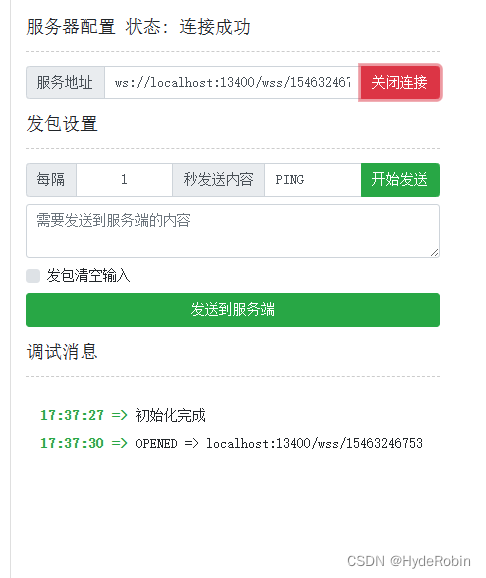阅读量:0
spring-boot基于websocket实现服务器推送消息到客户端
一、添加依赖
<dependency> <groupId>org.springframework.boot</groupId> <artifactId>spring-boot-starter-websocket</artifactId> <exclusions> <exclusion> <groupId>org.springframework.boot</groupId> <artifactId>spring-boot-starter-tomcat</artifactId> </exclusion> </exclusions> </dependency> 一定要将tomcat依赖包排除掉 否则会报错 javax.websocket.server.ServerContainer not available
二、添加配置类
通过配置类 启用WebSocket的支持:
import org.springframework.context.annotation.Bean; import org.springframework.context.annotation.Configuration; import org.springframework.web.socket.server.standard.ServerEndpointExporter; /** * @Author: Robin * @ClassName: WebSocketConfig * @Description: 开启WebSocket支持的配置类 * @DateTime: 2024/2/27 14:27 */ @Configuration public class WebSocketConfig { @Bean public ServerEndpointExporter serverEndpointExporter() { return new ServerEndpointExporter(); } } 三、创建WebSocketEndpoint处理类
import org.springframework.stereotype.Component; import org.springframework.stereotype.Service; import javax.websocket.*; import javax.websocket.server.PathParam; import javax.websocket.server.ServerEndpoint; import java.util.concurrent.ConcurrentHashMap; /** * @Author: Robin * @ClassName: WebSocketEndpoint * @Description: websocket连接接口 * @DateTime: 2024/2/27 10:57 */ @ServerEndpoint("/wss/{id}") @Component @Service public class WebSocketEndpoint { // 用于存储所有打开的会话,键是唯一的客户端ID private static final ConcurrentHashMap<String, Session> sessions = new ConcurrentHashMap<>(); private String id; @OnOpen public void onOpen(@PathParam("id") String id, Session session) { // 生成一个唯一的客户端ID sessions.put(id, session); this.id = id; System.out.println("连接已打开,客户端ID: " + id); } @OnMessage public void onMessage(String message, Session session) { System.out.println("收到消息: " + message); } @OnClose public void onClose(Session session) { String clientId = this.id; sessions.remove(clientId); System.out.println("连接已关闭,客户端ID: " + clientId); } @OnError public void onError(Session session, Throwable throwable) { String clientId = this.id; sessions.remove(clientId); System.out.println("发生错误,客户端ID: " + clientId); throwable.printStackTrace(); } // 用于向特定客户端发送消息的方法 public static void sendMessageToClient(String id, String message) { Session session = sessions.get(id); if (session != null && session.isOpen()) { try { session.getAsyncRemote().sendText(message); } catch (Exception e) { System.out.println("发送消息时发生错误,客户端ID: " + id); e.printStackTrace(); } } } } 连接时传入的id为业务系统中用户的身份id便于确认当前用的身份,已key的形式存入sessions的map中,当需要给指定的用户推送消息时候只需要传入id便可找到对应的session
四、测试连接
websocket在线测试工具有很多、postman也可以进行测试
我自己用的是 WebSocket在线测试工具 (wstool.js.org)
websocket请求分为两种:ws和wss
ws:针对于没有ssl证书的域名,可以理解为http
wss:针对于有ssl证书的域名,可以理解为https
1、本地服务连接
当调用本地服务测试时要采用ws的请求形式,wss是调不通的
ws://localhost:13400/wss/{id}
2、服务器连接
服务器如果采用了nginx代理,则需要修改nginx配置文件,添加针对于wss请求的配置参数
location /wss { proxy_pass http://127.0.0.1:13400; proxy_http_version 1.1; proxy_set_header Upgrade $http_upgrade; proxy_set_header Connection "upgrade"; # 默认60s断开连接 proxy_read_timeout 60s; } 请求地址:wss://域名/wss/{id}
eader Upgrade $http_upgrade;
proxy_set_header Connection “upgrade”;
# 默认60s断开连接
proxy_read_timeout 60s;
}
请求地址:wss://域名/wss/{id} 